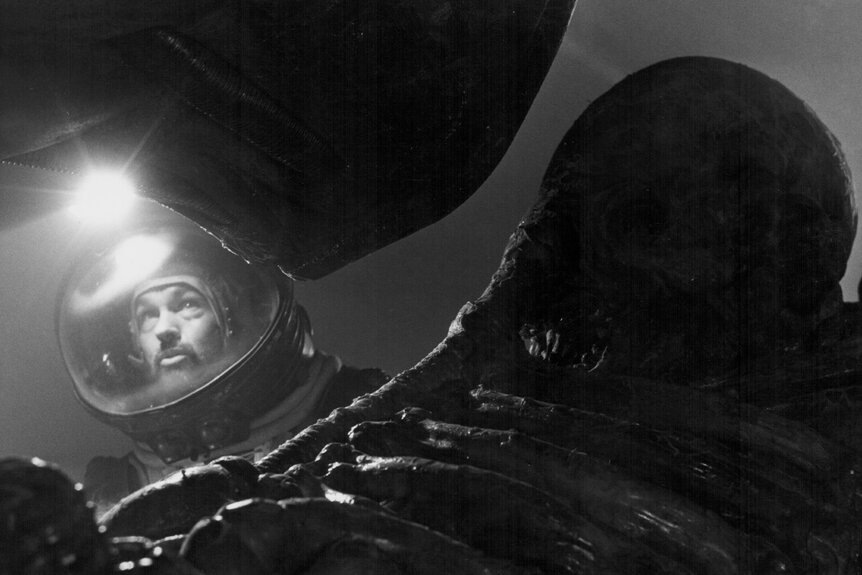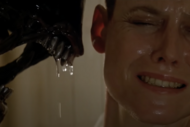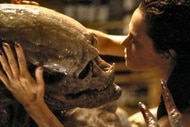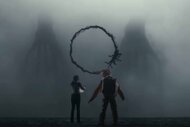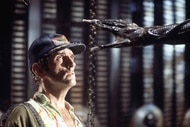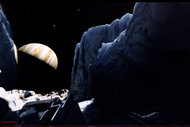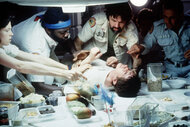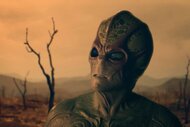Create a free profile to get unlimited access to exclusive videos, sweepstakes, and more!
A Timeline of the Alien Franchise's Xenomorph in All Its Terrifying Forms
Look back at how the Xenomorph, one of cinema's scariest monsters, was born and evolved across the Alien franchise.
If asked to name one of cinema's most effective and enduring monsters, without a doubt, most folks would rank the Xenomorph of the Alien franchise up near the top. First introduced to audiences in Ridley Scott's 1979 horror/thriller, Alien, the original, bipedal creature was violently birthed from the chest of Kane (John Hurt) and evolved from an egg to a free-standing, eviscerating monster in just under two hours.
Originally referred to as just an alien, it was in James Cameron's 1986 sequel, Aliens, that the monster was first labeled as a "Xenomorph" by Colonial Marine Lieutenant Gorman (William Hope), while referencing the species from a case file. Going forward, the term became the official reference to the franchise's evolving creature, even though it's never been formally named.
Call it whatever you want, the Xenomorph remains a terrifying concept with its skeletal, humanoid frame, elongated skull, and inner and outer jaws. Dripping concentrated acid for blood and possessing a paralyzing tail stinger, the Xenomorph was conceived to be an almost unstoppable foe that exhibits no emotions or interests, other than to propagate its species. As the Xenomorph turns 45-years-old this year, and with many of the films appearing on SYFY this month, let's track the origin and evolution of the monster through the franchise's expansive timeline.
For More on Alien:
Game Over, Man! The 13 Scariest and Most Iconic Moments From the Alien Franchise
Alien Resurrection turns 25: Does Ripley’s last gasp still matter?
It’s a miracle that Alien 3 ever got out of development hell
The Design Origins of the Alien Franchise's Xenomorph
The monster in the Alien screenplay is technically the brain baby of co-screenwriter Ronald Shusett. While trying to crack the script with co-writer Dan O'Bannon, Shusett recounted in the Alien documentary on the Alien Quadrilogy box set that he remembered a troubling dream about the alien: "I have an idea: the monster screws one of them, planting its egg in his body, and then bursting out of his chest." It so disturbed both writers that they wrote it down, and it eventually became one of the most distinguishing characteristics of their monster.
But the Xenomorph didn't really come to life until concept artist H. R. Giger was brought onto the film by O'Bannon and Scott. Giger's pre-existing illustration from 1976, Necronom IV, became the figure that Scott wanted Giger to use as the design basis for the film's alien. Giger was hired to design the adult version, the implanted egg, and then the chestburster monster. When Scott approved the concepts, it was Italian special effects designer Carlo Rambaldi who would turn those illustrations into functional costumes for the adult alien, and prop monsters for the younger variations. Their collaboration was so impressive that Giger and Rambaldi won the 1980 Academy Award for Visual Effects for their alien design.
The Timeline of the Alien Franchise's Xenomorph Creature
Prometheus (2089 – 2093)
To date, this is the beginning of the franchise's timeline introducing what will eventually become the Xenomorph. In Scott's Alien prequel, Prometheus (2012), archaeologist Elizabeth Shaw (Noomi Rapace) becomes unknowingly impregnated by a foreign squid-like creature. In a harrowing sequence, she performs a solo surgical extraction of the thing from her body, which lives and escapes into the ship. Her "offspring" attaches to an engineer humanoid, implants an egg, and then bursts from its chest once gestated. It's a murky visual connection to the engineer figure featured in the Alien film.
Alien: Covenant (2104)
A mystery planet is home to David the android's (Michael Fassbender) creature experiments as he seeks to create the "perfect life form." The humans who land on the planet encounter David's alien mutations, which are born from his pathogen experimentation. The film introduces a pale Neomorph alien, along with the growth iterations of the alien known as the chestburster and facehugger phases of development. The familiar adult stage Xenomorph appears in the last portion of the film, laying the groundwork for the visual evolution of the creature to connect to Alien.
Alien (2122)
From egg to facehugger to chestburster to adult creature, Alien provides the entire gestational lifespan of a Xenomorph, as audiences watch it infect the Nostromo crew and then obliterate everyone, one by one. The lone survivors are Lt. Ellen Ripley (Sigourney Weaver) and Jonesy the cat.
Aliens and Alien 3 (2179)
Along with the now familiar facehugger, chestburster, and adult Xenomorph iterations of the alien, Aliens introduces the Queen. A massive creature with a large, flat crest on its head, the Queen is the breeder of its colony. It finds a humid space to create a protected nest, then guards her eggs, which will eventually produce facehuggers for egg implantation in other organic hosts. She can be mobile, as shown when she leaves her nest to stop the threat of Ripley and her flamethrower.
In David Fincher's Alien 3, a facehugger is hatched from an egg in the escape pod of the Sulaco. When the ship crashes onto Fiorina 161, the facehugger attaches to a prisoner there and births a Xenomorph that breeds more of its kind, which wipes out the installation. The film also introduces the Dog Alien hybrid creature.
Alien Resurrection (2379)
In Alien Resurrection, a cloned version of Ellen Ripley is brought to life in the future, where an Alien Queen has also been cloned. The United Systems Military (USM) is trying to breed and control aliens as weapons, and have created a lab full of mutated abominations including a humanoid mutant hybrid called a Newborn. This evolved Xenomorph can also swim.
Watch the many terrifying Xenomorphs in the Alien films on SYFY throughout March!




